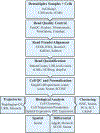Methodologies for Following EMT In Vivo at Single Cell Resolution
- PMID: 32939729
- PMCID: PMC7949293
- DOI: 10.1007/978-1-0716-0779-4_23
Methodologies for Following EMT In Vivo at Single Cell Resolution
Abstract
An epithelial-mesenchymal transition (EMT) occurs in almost every metazoan embryo at the time mesoderm begins to differentiate. Several embryos have a long record as models for studying an EMT given that a known population of cells enters the EMT at a known time thereby enabling a detailed study of the process. Often, however, it is difficult to learn the molecular details of these model EMT systems because the transitioning cells are a minority of the population of cells in the embryo and in most cases there is an inability to isolate that population. Here we provide a method that enables an examination of genes expressed before, during, and after the EMT with a focus on just the cells that undergo the transition. Single cell RNA-seq (scRNA-seq) has advanced as a technology making it feasible to study the trajectory of gene expression specifically in the cells of interest, in vivo, and without the background noise of other cell populations. The sea urchin skeletogenic cells constitute only 5% of the total number of cells in the embryo yet with scRNA-seq it is possible to study the genes expressed by these cells without background noise. This approach, though not perfect, adds a new tool for uncovering the mechanism of EMT in this cell type.
Keywords: Epithelial-mesenchymal transition; Sea urchin; Single cell RNA-sequencing; Tissue morphogenesis.
Figures

Similar articles
-
A sea urchin in vivo model to evaluate Epithelial-Mesenchymal Transition.Dev Growth Differ. 2017 Apr;59(3):141-151. doi: 10.1111/dgd.12353. Epub 2017 Apr 24. Dev Growth Differ. 2017. PMID: 28436008
-
Finding cell-specific expression patterns in the early Ciona embryo with single-cell RNA-seq.Sci Rep. 2020 Mar 18;10(1):4961. doi: 10.1038/s41598-020-61591-1. Sci Rep. 2020. PMID: 32188910 Free PMC article.
-
Single cell RNA-seq in the sea urchin embryo show marked cell-type specificity in the Delta/Notch pathway.Mol Reprod Dev. 2019 Aug;86(8):931-934. doi: 10.1002/mrd.23181. Epub 2019 Jun 14. Mol Reprod Dev. 2019. PMID: 31199038 Free PMC article.
-
Gastrulation in the sea urchin.Curr Top Dev Biol. 2020;136:195-218. doi: 10.1016/bs.ctdb.2019.08.004. Epub 2019 Oct 22. Curr Top Dev Biol. 2020. PMID: 31959288 Free PMC article. Review.
-
Ingression of primary mesenchyme cells of the sea urchin embryo: a precisely timed epithelial mesenchymal transition.Birth Defects Res C Embryo Today. 2007 Dec;81(4):241-52. doi: 10.1002/bdrc.20113. Birth Defects Res C Embryo Today. 2007. PMID: 18228256 Review.
Cited by
-
New techniques for creating parthenogenetic larvae of the sea urchin Lytechinus pictus for gene expression studies.Dev Dyn. 2021 Dec;250(12):1828-1833. doi: 10.1002/dvdy.377. Epub 2021 Jun 22. Dev Dyn. 2021. PMID: 34042247 Free PMC article.
-
Quantifying the Epithelial-to-Mesenchymal Transition (EMT) from Bench to Bedside.Cancers (Basel). 2022 Feb 23;14(5):1138. doi: 10.3390/cancers14051138. Cancers (Basel). 2022. PMID: 35267444 Free PMC article. Review.
-
Developmental single-cell transcriptomics in the Lytechinus variegatus sea urchin embryo.Development. 2021 Oct 1;148(19):dev198614. doi: 10.1242/dev.198614. Epub 2021 Sep 27. Development. 2021. PMID: 34463740 Free PMC article.
-
Stationed or Relocating: The Seesawing EMT/MET Determinants from Embryonic Development to Cancer Metastasis.Biomedicines. 2021 Sep 18;9(9):1265. doi: 10.3390/biomedicines9091265. Biomedicines. 2021. PMID: 34572451 Free PMC article. Review.
-
Reprogramming of cells during embryonic transfating: overcoming a reprogramming block.Development. 2024 Dec 15;151(24):dev203152. doi: 10.1242/dev.203152. Epub 2024 Dec 20. Development. 2024. PMID: 39628450
References
-
- Andrews S, FastQC: a quality control tool for high throughput sequence data. 2010.
-
- Andrews T (2019). M3Drop: Michaelis-Menten Modelling of Dropouts in single-cell RNASeq. R package version 1.10.0, https://github.com/tallulandrews/M3Drop.
-
- Becht E, et al. “Dimensionality Reduction for Visualizing Single-Cell Data Using Umap.” Nat Biotechnol (2018). Print. - PubMed
-
- Bray NL, et al. “Near-Optimal Probabilistic Rna-Seq Quantification.” Nat Biotechnol 34.5 (2016): 525–7. Print. - PubMed
Publication types
MeSH terms
Grants and funding
LinkOut - more resources
Full Text Sources
Miscellaneous

